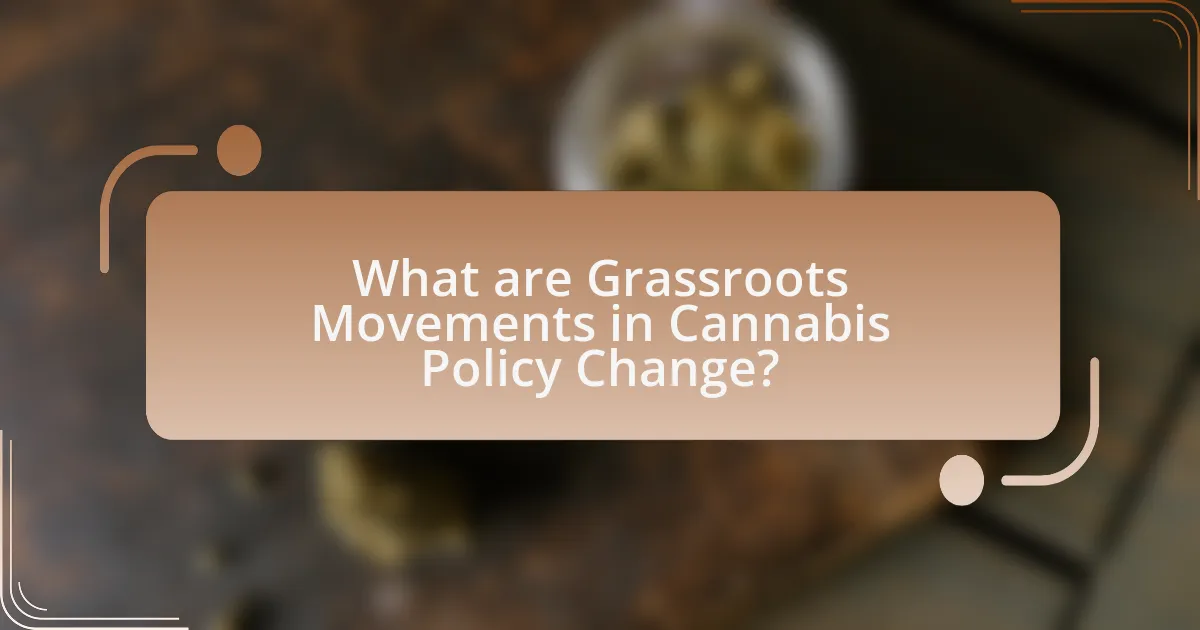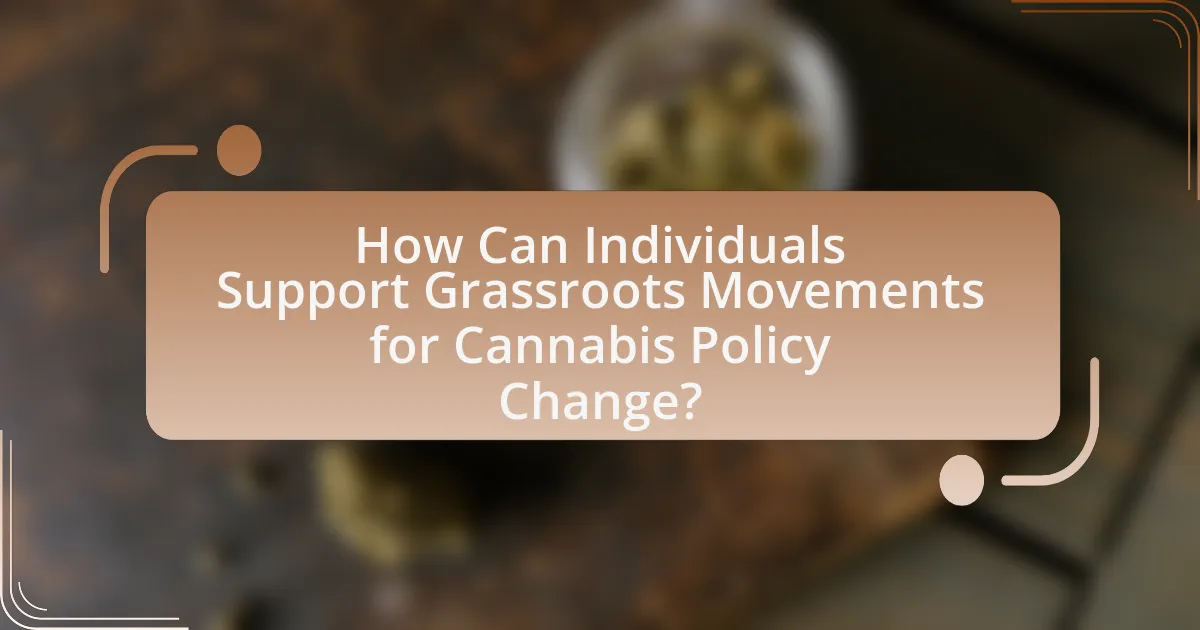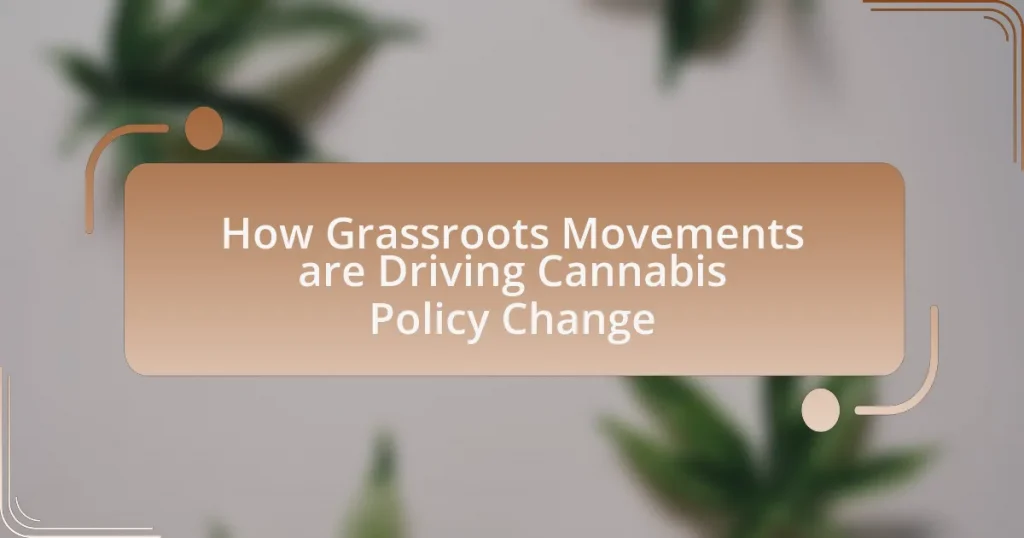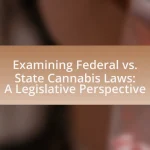Grassroots movements are community-driven initiatives that aim to influence cannabis policy change through local advocacy, public education, and mobilization efforts. These movements have played a crucial role in the legalization and decriminalization of cannabis in various states, utilizing strategies such as petitions, social media campaigns, and coalition building to raise awareness and garner public support. Key examples include successful campaigns in states like Colorado and California, where grassroots organizations effectively engaged communities and collaborated with lawmakers to drive legislative reform. The article explores the strategies employed by these movements, their impact on public opinion and the political landscape, as well as the challenges they face in advocating for cannabis policy change.

What are Grassroots Movements in Cannabis Policy Change?
Grassroots movements in cannabis policy change are community-driven efforts aimed at influencing legislation and public perception regarding cannabis use and regulation. These movements often emerge from local advocacy groups, individuals, and organizations that mobilize citizens to push for reforms, such as legalization or decriminalization of cannabis. For instance, the legalization of cannabis in states like Colorado and Washington was significantly propelled by grassroots campaigns that gathered public support through petitions, rallies, and educational initiatives. These movements rely on grassroots organizing techniques, including door-to-door canvassing and social media outreach, to engage and inform the public, demonstrating their effectiveness in shaping cannabis policy at local and state levels.
How do grassroots movements influence cannabis legislation?
Grassroots movements significantly influence cannabis legislation by mobilizing public support, raising awareness, and advocating for policy changes at local, state, and national levels. These movements often utilize petitions, social media campaigns, and community organizing to educate the public about the benefits of cannabis legalization and to challenge existing laws. For instance, the successful legalization of cannabis in states like Colorado and California can be attributed to grassroots efforts that gathered substantial voter support, demonstrated through initiatives like the 2012 Colorado Amendment 64, which passed with 55% of the vote. Additionally, grassroots organizations often collaborate with lawmakers to draft legislation, ensuring that the voices of advocates and affected communities are represented in the policy-making process.
What strategies do grassroots movements employ to advocate for policy change?
Grassroots movements employ strategies such as community organizing, public awareness campaigns, coalition building, and direct lobbying to advocate for policy change. Community organizing involves mobilizing local residents to participate in advocacy efforts, which can amplify voices and create a collective impact. Public awareness campaigns utilize social media, events, and educational materials to inform the public and policymakers about specific issues, such as cannabis legalization. Coalition building brings together diverse groups to strengthen advocacy efforts, increasing resources and influence. Direct lobbying involves engaging with lawmakers to present research, personal stories, and data that support policy changes, such as the benefits of cannabis reform. These strategies have been effective in various contexts, including the successful legalization of cannabis in multiple states, demonstrating the power of grassroots advocacy in shaping policy.
How do grassroots movements mobilize community support for cannabis reform?
Grassroots movements mobilize community support for cannabis reform by fostering local engagement, raising awareness, and building coalitions. These movements often utilize social media platforms to disseminate information about the benefits of cannabis reform, such as economic opportunities and social justice implications. For instance, the Marijuana Policy Project has successfully engaged communities by organizing events and providing educational resources, which have led to increased public support and legislative changes in various states. Additionally, grassroots organizations often collaborate with local leaders and activists to amplify their message, creating a unified front that resonates with community values and concerns. This approach has been effective in shifting public opinion, as evidenced by the growing number of states that have legalized cannabis in recent years, reflecting a significant change in societal attitudes driven by grassroots advocacy.
Why are grassroots movements essential for cannabis policy change?
Grassroots movements are essential for cannabis policy change because they mobilize community support and influence public opinion, leading to legislative reform. These movements often consist of local activists who advocate for policy changes through education, awareness campaigns, and direct engagement with lawmakers. For instance, the legalization of cannabis in states like Colorado and California was significantly driven by grassroots organizations that gathered signatures for ballot initiatives, demonstrating the power of collective action. Research indicates that grassroots efforts can effectively shift perceptions and create a political climate conducive to policy change, as seen in the increasing number of states legalizing cannabis since the early 2000s.
What role do grassroots movements play in shaping public opinion on cannabis?
Grassroots movements play a crucial role in shaping public opinion on cannabis by mobilizing community support and raising awareness about its benefits and risks. These movements often utilize social media campaigns, public demonstrations, and educational outreach to inform the public and challenge existing stigmas associated with cannabis use. For instance, the National Organization for the Reform of Marijuana Laws (NORML) has been instrumental in advocating for cannabis legalization, contributing to a significant shift in public perception; a Gallup poll in 2021 indicated that 68% of Americans support legalizing cannabis, a marked increase from just 25% in 1995. This demonstrates how grassroots efforts can effectively influence societal attitudes and drive policy changes regarding cannabis.
How do grassroots movements impact the political landscape regarding cannabis?
Grassroots movements significantly influence the political landscape regarding cannabis by mobilizing public support and advocating for policy changes. These movements often raise awareness about the benefits of cannabis legalization, leading to increased voter engagement and pressure on lawmakers. For instance, the successful legalization of cannabis in states like Colorado and California can be attributed to organized grassroots campaigns that collected signatures for ballot initiatives and lobbied for legislative reforms. Research from the American Journal of Public Health indicates that states with active grassroots organizations saw a higher likelihood of passing cannabis-related legislation, demonstrating the direct impact of these movements on policy outcomes.

What are the Key Examples of Successful Grassroots Movements?
Key examples of successful grassroots movements include the legalization of cannabis in various U.S. states, driven by organizations like the Marijuana Policy Project and NORML. These movements mobilized public support through petitions, educational campaigns, and community engagement, resulting in significant policy changes. For instance, Colorado and Washington legalized recreational cannabis in 2012, largely due to grassroots efforts that highlighted the benefits of legalization, such as increased tax revenue and reduced criminal justice costs. Additionally, the 2016 ballot initiative in California, Proposition 64, which legalized recreational use, was supported by extensive grassroots campaigning that emphasized social justice and economic benefits. These examples demonstrate how grassroots movements effectively influence cannabis policy through organized advocacy and public mobilization.
How have specific grassroots movements achieved cannabis legalization?
Specific grassroots movements have achieved cannabis legalization through organized advocacy, public education, and mobilization of community support. For instance, the Marijuana Policy Project (MPP) has played a crucial role in various states by initiating ballot measures and lobbying for legislative changes, resulting in the legalization of cannabis in states like Colorado and Washington. Additionally, organizations such as NORML (National Organization for the Reform of Marijuana Laws) have focused on raising awareness about the benefits of legalization, influencing public opinion, and providing legal resources for activists. These efforts have been supported by significant public engagement, as evidenced by the increasing number of states legalizing cannabis, with over 20 states having legalized recreational use by 2023.
What lessons can be learned from successful cannabis advocacy campaigns?
Successful cannabis advocacy campaigns demonstrate the importance of grassroots mobilization, effective messaging, and coalition-building. Grassroots mobilization engages local communities, fostering a sense of ownership and urgency, which has been pivotal in campaigns like California’s Proposition 215 in 1996, the first state to legalize medical cannabis. Effective messaging, tailored to resonate with diverse audiences, has proven essential; for instance, campaigns that highlight personal stories of medical cannabis users have humanized the issue and garnered broader support. Coalition-building among various stakeholders, including health professionals, civil rights organizations, and business interests, has strengthened advocacy efforts, as seen in the successful legalization initiatives in states like Colorado and Washington in 2012. These campaigns illustrate that a multifaceted approach, combining local engagement, relatable narratives, and diverse alliances, is crucial for advancing cannabis policy change.
How did grassroots movements overcome opposition to cannabis policy change?
Grassroots movements overcame opposition to cannabis policy change by mobilizing community support, leveraging social media, and engaging in strategic lobbying. These movements organized local campaigns that educated the public on the benefits of cannabis legalization, which helped shift public opinion. For instance, the National Organization for the Reform of Marijuana Laws (NORML) and other advocacy groups utilized social media platforms to disseminate information and rally supporters, significantly increasing visibility and engagement. Additionally, grassroots efforts often included direct lobbying of lawmakers, where constituents shared personal stories and data on the economic and health benefits of cannabis, influencing legislative decisions. This combination of community engagement, effective communication, and direct political action has been crucial in overcoming institutional resistance to cannabis policy reform.
What challenges do grassroots movements face in cannabis advocacy?
Grassroots movements in cannabis advocacy face significant challenges, including limited funding, regulatory barriers, and public stigma. Limited funding restricts their ability to effectively organize campaigns and reach broader audiences, as many rely on small donations and volunteer efforts. Regulatory barriers, such as complex legal frameworks and varying state laws, complicate advocacy efforts and hinder the ability to mobilize support. Additionally, public stigma surrounding cannabis use can deter potential allies and create resistance among policymakers, making it difficult for grassroots movements to gain traction and influence change. These challenges collectively impede the progress of grassroots initiatives aimed at reforming cannabis policies.
How do funding and resources affect grassroots movements’ effectiveness?
Funding and resources significantly enhance the effectiveness of grassroots movements by providing essential support for outreach, organization, and advocacy efforts. Adequate funding allows these movements to mobilize larger groups, create impactful campaigns, and sustain long-term initiatives. For instance, a study by the Movement Advancement Project found that well-funded grassroots organizations are more likely to achieve policy changes, as they can invest in strategic communications and community engagement. Additionally, resources enable access to expert knowledge and tools, which can amplify the movement’s message and increase its visibility. This correlation between funding and effectiveness is evident in successful cannabis policy reform efforts, where financial backing has facilitated extensive public education and lobbying activities, leading to significant legislative victories.
What legal and political obstacles do grassroots movements encounter?
Grassroots movements encounter significant legal and political obstacles, including restrictive regulations, lack of access to political processes, and opposition from established interests. These movements often face legal challenges such as stringent campaign finance laws that limit their ability to raise funds and mobilize support. Additionally, grassroots organizations may struggle to gain recognition and legitimacy within political systems that favor established parties and lobbyists, making it difficult to influence policy changes. For instance, in the context of cannabis policy, many grassroots movements have encountered pushback from law enforcement and regulatory bodies that uphold existing prohibitions, thereby hindering their efforts to advocate for reform.

How Can Individuals Support Grassroots Movements for Cannabis Policy Change?
Individuals can support grassroots movements for cannabis policy change by actively participating in advocacy efforts, donating to organizations focused on reform, and engaging in community education initiatives. Participation can include attending rallies, signing petitions, and contacting local representatives to express support for cannabis legalization or decriminalization. Financial contributions to established advocacy groups, such as the Marijuana Policy Project or NORML, can help fund campaigns and outreach efforts. Additionally, educating oneself and others about the benefits of cannabis policy reform can foster informed discussions and build community support, which is crucial for driving legislative change. Research indicates that grassroots movements have significantly influenced policy changes in various states, demonstrating the effectiveness of collective action in achieving reform.
What actions can individuals take to contribute to grassroots movements?
Individuals can contribute to grassroots movements by actively participating in local advocacy efforts, organizing community events, and engaging in educational outreach. For instance, individuals can join or form local groups focused on cannabis policy reform, which can amplify their voices and influence decision-makers. Research indicates that grassroots mobilization has been effective in changing cannabis laws in various states, demonstrating the power of collective action. Additionally, individuals can utilize social media platforms to raise awareness and share information, further expanding the reach of grassroots initiatives.
How can social media be leveraged to support cannabis advocacy?
Social media can be leveraged to support cannabis advocacy by facilitating communication, mobilizing supporters, and disseminating information. Platforms like Twitter, Facebook, and Instagram allow advocates to share personal stories, research, and updates on legislation, which can raise awareness and foster community engagement. For instance, campaigns such as #CannabisCommunity have successfully united individuals and organizations, amplifying their voices and increasing visibility for cannabis-related issues. Additionally, social media enables real-time interaction, allowing advocates to respond quickly to misinformation and engage with policymakers directly, thereby influencing public opinion and legislative outcomes.
What are effective ways to engage with local cannabis advocacy groups?
Effective ways to engage with local cannabis advocacy groups include attending their meetings, volunteering for events, and participating in campaigns. Engaging directly with these groups fosters relationships and demonstrates commitment to the cause. For instance, attending meetings allows individuals to understand the group’s objectives and contribute ideas, while volunteering for events helps build community support and awareness. Participating in campaigns, such as letter-writing or lobbying efforts, amplifies the group’s message and can lead to tangible policy changes. Research indicates that grassroots movements significantly influence cannabis policy, as seen in states where local advocacy has led to successful legalization efforts.
What best practices should individuals follow when supporting grassroots movements?
Individuals should prioritize active engagement and informed advocacy when supporting grassroots movements. This involves participating in local events, volunteering time, and contributing resources to amplify the movement’s message. Research indicates that grassroots movements, such as those advocating for cannabis policy reform, gain traction through community involvement and collective action, as seen in the successful legalization efforts in states like Colorado and California. Furthermore, individuals should educate themselves on the issues at hand, ensuring they can effectively communicate the movement’s goals and challenges, which enhances credibility and fosters broader support.
How can individuals educate themselves and others about cannabis policy issues?
Individuals can educate themselves and others about cannabis policy issues by engaging with credible resources, participating in community discussions, and advocating for informed policy changes. Accessing reputable websites, such as the National Organization for the Reform of Marijuana Laws (NORML) and the Drug Policy Alliance, provides factual information on current laws and reforms. Attending local town hall meetings or forums allows individuals to discuss cannabis policies directly with lawmakers and community leaders. Additionally, sharing knowledge through social media platforms and organizing educational workshops can help raise awareness and foster informed conversations about cannabis legislation. Research indicates that grassroots movements significantly influence policy change, as seen in states where public support for legalization has led to legislative action.
What are the most impactful ways to volunteer for cannabis advocacy efforts?
The most impactful ways to volunteer for cannabis advocacy efforts include participating in local advocacy groups, engaging in educational outreach, and assisting with policy reform initiatives. Local advocacy groups often focus on community engagement and mobilization, which can significantly influence public opinion and policy decisions. Educational outreach, such as organizing workshops or distributing informational materials, helps to inform the public about the benefits and legal aspects of cannabis, thereby fostering a more informed electorate. Assisting with policy reform initiatives, including lobbying efforts and public comment submissions, directly contributes to shaping legislation and regulations surrounding cannabis use. These methods have been shown to effectively mobilize grassroots support, as evidenced by successful campaigns in states like California and Colorado, where organized volunteer efforts have led to significant policy changes.


